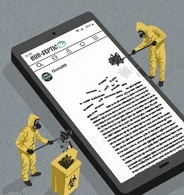
Adelekan Oluwaseun Ojo.
Toxins lurk in numerous corners of our daily lives, often unnoticed until they wreak havoc on our health. From the air we breathe to the food we eat, toxins can infiltrate our bodies through various avenues, posing serious risks to our well-being. Understanding the diverse sources of human contact with toxins is crucial for safeguarding our health and ensuring a safer environment for future generations.
Environmental Pollution:
The modern world is rife with environmental pollutants, ranging from industrial emissions to vehicle exhaust. Air pollution, laden with harmful substances like particulate matter, ozone, and nitrogen dioxide, can penetrate deep into our respiratory systems, leading to respiratory ailments, cardiovascular diseases, and even cancer. Water bodies contaminated with heavy metals, pesticides, and chemical waste further contribute to the toxic burden on human health, jeopardizing both drinking water supplies and aquatic ecosystems.
Household Products:
Common household items may harbor toxins that pose risks to human health. Cleaning products, personal care items, and even furnishings can contain harmful chemicals such as phthalates, parabens, and volatile organic compounds (VOCs). Prolonged exposure to these toxins through inhalation, skin contact, or ingestion can lead to respiratory issues, skin irritations, hormone disruptions, and neurological disorders.
Food and Beverages:
The food we consume may contain a cocktail of toxins, including pesticides, heavy metals, and food additives. Pesticide residues on fruits and vegetables, mercury in seafood, and contaminants in processed foods can all contribute to toxic exposures. Additionally, certain cooking methods, such as grilling or frying at high temperatures, can produce carcinogenic compounds like polycyclic aromatic hydrocarbons (PAHs) and acrylamide, further elevating health risks.
Occupational Hazards:
Workers in various industries face occupational hazards that expose them to toxins on a daily basis. Chemical manufacturing plants, agricultural settings, and construction sites are just a few examples where workers may encounter dangerous substances like solvents, pesticides, heavy metals, and asbestos. Without proper safety measures and protective equipment, these exposures can lead to acute poisoning, chronic illnesses, and long-term health complications.
Lifestyle Choices:
Certain lifestyle habits can increase our exposure to toxins and exacerbate their harmful effects. Smoking tobacco introduces a plethora of toxins into the body, including nicotine, tar, and carbon monoxide, heightening the risk of cancer, respiratory diseases, and cardiovascular disorders. Alcohol consumption, illicit drug use, and exposure to secondhand smoke further compound these risks, underscoring the importance of healthy lifestyle choices in minimizing toxic exposures.
Electronic Devices:
In the digital age, electronic devices have become ubiquitous, yet they also harbor potential toxins. Components like lead, mercury, and brominated flame retardants found in electronics pose risks during manufacturing, use, and disposal phases. Improper handling of electronic waste (e-waste) can release these toxins into the environment, contaminating soil, water, and air, and posing health hazards to communities living in proximity to e-waste disposal sites.
Pharmaceuticals and Healthcare Products:
While pharmaceuticals play a crucial role in healthcare, they can also introduce toxins into the body, particularly when misused or improperly disposed of. Over-the-counter medications, prescription drugs, and healthcare products like disinfectants and medical devices may contain hazardous chemicals that can accumulate in the body over time, leading to adverse effects and complications.
Toxins infiltrate our lives through various channels, posing significant threats to human health and the environment. Heightened awareness, stringent regulations, and proactive measures are essential for mitigating exposures and minimizing risks associated with toxins. By adopting sustainable practices, advocating for safer alternatives, and promoting environmental stewardship, we can strive towards a healthier, toxin-free future for all.
Preventing and Managing Toxins in the Body
In today’s world, we encounter toxins from various sources daily, ranging from pollution in the air we breathe to chemicals in the food we eat, as stated above. Understanding how to prevent and manage these toxins is essential for maintaining optimal health and well-being. This article aims to provide a comprehensive guide on strategies to minimize toxin exposure and effectively manage toxins within the body.
Diet and Nutrition:
– Choose organic foods whenever possible to reduce exposure to pesticides and synthetic chemicals.
– Incorporate plenty of fresh fruits and vegetables rich in antioxidants, which help neutralize free radicals and detoxify the body.
– Drink a lot of water to flush out toxins and support the body’s natural detoxification processes.
– Limit processed foods, artificial additives, and refined sugars, which can burden the body’s detoxification pathways.
Detoxification Practices:
– Engage in regular physical activity to stimulate circulation and promote the elimination of toxins through sweat.
– Practice deep breathing exercises to enhance oxygenation and support the body’s detoxification mechanisms.
– Consider incorporating detoxifying herbs and supplements such as milk thistle, dandelion root, and spirulina into your routine. This is where Jigsimur herbal drink will be of help. Every living human being needs it for the proper detoxification of the body.
– Sauna therapy can help facilitate detoxification through sweating and promoting lymphatic drainage.
Reduce Environmental Exposure:
– Use natural cleaning and personal care products to minimize exposure to harmful chemicals found in conventional products.
– Install air purifiers in your home to reduce indoor air pollution and allergens.
– Avoid smoking and limit exposure to secondhand smoke, which contains numerous toxins harmful to health.
– Filter tap water to remove contaminants such as chlorine, heavy metals, and pharmaceutical residues.
Stress Management:
– Chronic stress can impair the body’s detoxification processes, so prioritize stress-reduction techniques such as meditation, yoga, and mindfulness.
– Ensure an adequate amount of sleep each night, as sleep is essential for cellular repair and detoxification.
– Cultivate healthy coping mechanisms for stress, such as spending time in nature, practicing hobbies, or seeking support from friends and family.
Liver Support:
– The liver is a crucial organ for detoxification, so support its function with a balanced diet, rich in liver-friendly foods such as cruciferous vegetables, garlic, and turmeric.
– Limit alcohol consumption, as excessive alcohol intake can overwhelm the liver’s detoxification capacity.
– Consider incorporating liver-supportive supplements such as N-acetylcysteine (NAC) and glutathione precursors.
Conclusion:
By implementing these strategies, you can significantly reduce your exposure to toxins and support your body’s natural detoxification processes. Remember that small, consistent changes over time can lead to significant improvements in your overall health and well-being. Prioritize toxin prevention and management as an essential component of your holistic approach to health maintenance.





